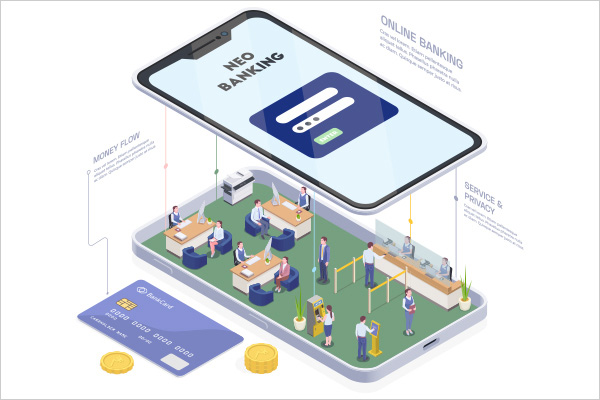Being a partner-of-choice for Indian neo banks

While traditional banks continue to embrace a digital-first approach to banking, the rapidly changing needs of the customer have given birth to a new-age concept, namely ‘neo-banks.’ Will this revolution affect the existing banking system?
Let’s understand the role of neo-banks in the current digital transformation journey:
The first phase of the fintech revolution in India began post 2005, with an introduction and steady adoption of digital payments. The second phase around 2015-16 received a hard nudge from the demonetisation exercise, leading to rapid growth of eKYC (electronic know your customer) processes and UPI (unified payments interface) infrastructure. This time also saw an introduction of co-lending and experiments in FLDG (first loan default guarantee) enterprises. The third phase that began 2018 onwards has seen a boost in open (neo) banking through evolved API stacks, compliance automation and robust data sharing mechanisms. With an exclusive digital presence that opens up possibilities, neo banks have been termed as ‘challengers’ and ‘disruptors’. Indirect regulations in India require neo banks to partner with regulated banks to offer services. This enables a potentially symbiotic relationship between the two. How does RBL Bank, approach this rapidly evolving environment and emerge as a partner-of-choice for Indian neo banks? This conversation with Topendra Bhattacharjee (Head – Digital Bank, Direct Channels and Analytics at RBL Bank) helps us delve deeper.
The advantages that neo banks bring to the table are multifold. Innovative product suites result in a better banking experience for customers, which is favorable for banks. Better access to customer behaviour and data analytics helps improve engagement levels for the user base. The digital-first nature of neo banks helps traditional banking setups explore uncharted distribution formats, outreach and data monetisation opportunities. This, in addition to AI/ML and data science capabilities allows a distinct and a complementary step up. As a result, banks can take a decisive step towards inorganic growth through lower customer acquisition cost and upselling/cross-selling opportunities on the same channel. Topendra shares how RBL Bank has been well accepted as a neo bank partner with its technology-first intent, an evolved API stack and a highly successful partnership with Razorpay.
While banks have been proactive in partnering with technology-first neo-banks and fintech firms, there has been a mismatch in expectations of operational agility, infrastructure and skill sets. Quoting Topendra, “Both, at a customer-level and at fintech-level, the operational excellence that is expected by neo banks is extremely high, and very different from the legacy structures.” This could be attributed in one part to differing problem statements that are being addressed. For instance, the IDC report commissioned by Razorpay in October 2021 states how neo banks see SMEs as their primary market while legacy systems have always deprioritized serving this segment due to their “low individual turnover”. This underlines how organisational cultures of neo banks and legacy banks differ in their identification of problems and envisioning of solutions. Resources are only deployed accordingly, leading to the gap in their approach to work. Moreover, the report mentions how technology is not the only differentiating factor for neo banks, but only a means to an end. The focus for neo banks is on addressing unique customer needs through custom solutions in cases where “one size fits all” may not be suitable.
As a part of the partnership journey between a neo bank and a legacy bank, the partner introduction is followed by an evaluation of relevant APIs and understanding the customer journey. On agreement, APIs are customised, integrated and tested. On a successful beta launch, the partnership is ready to go live. It is key to note that the time to market reduces considerably as the API stack and respective teams mature with time.
There are three possible pitfalls:
- Limited understanding of the bank ecosystem may lead to lack of clarity in the use case. This can be pre-empted and resolved through diligent partner evaluation by deploying a standardised evaluation template – one that encompasses proposition, forecasting, key performance indicators and capital structure.
- Considering that both organisations would be learning as they build, ad-hoc requests for new customer journeys and frequent changes may emerge in the midst of other priorities. One way to resolve this is to co-create customer journeys to ensure feedback is promptly incorporated. Moreover, productising customer journey APIs with fixed time to market should allocate collective responsibility towards reinforcing the critical path.

- Lastly, lack of clarity on the ‘go-to’ plan could cause a hindrance, due to changes in scope. An apt resolution would be a phased launch supported by a responsibility matrix and predefined timelines that all stakeholders have agreed upon and are committed to.
It is indeed challenging for organizations of such widely different methodologies to partner and yield efficient returns. In addition to matching technology stacks and skill sets between the partnering organizations, the role of communication and intentful culture as contributing factors cannot be underestimated. “Technology is the most objective thing to solve,” adds Topendra. “True success of a neo bank is based on the mindset that teams employ, and a thorough understanding of the culture from top to bottom.”
He points towards the need for both sides of the table to introspect and adapt such that the partnership is mutually beneficial. The stress he lays on introspection, agility and customer centricity – the ‘softer’ aspects of collaboration – is significant, given RBL Bank’s track record of being ‘partners ka bank’. The intangibles can neither be purchased nor internalized overnight. As exhibited by Topendra and his teams, it is the buy-in at the very top and the frontline it empowers that could really make a difference in this burgeoning and truly exciting sector. Once partnerships flourish between the right partners, it is the consumer who would be the ultimate winner.

 Blog
Blog Blog
Blog



Comments
No comments yet.